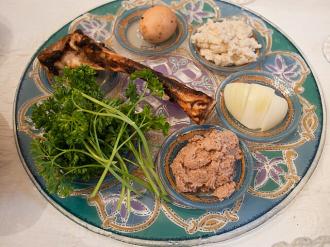Alan Freishtat will be in the Baltimore-Washington area on August 25th and August 26th. For more information or an appointment, please email Alan’s office at info@alanfitness.com or call 516-568-5027
It was week 4 of Donny’s weight loss program. He started out great! He had made enough changes in his eating to already make a big difference. His biggest challenge in terms of over eating was Shabbos, and he had finally conquered that challenge. For the first time in his adult life, he exercising and not only was his weight dropping but he felt good and had more energy too. But when he walked into my office last time, I noticed right away that he had a noticeable limp and was in pain. He sat down and told me that he hopes the scale still went down this week because he hadn’t exercised for the last 3 days. I asked him what happened and he told me that at the end of his walk that Monday morning, he wasn’t paying attention and didn’t see a pot hole on the sidewalk. He hit the side of the hole and his ankle bent to the side. It was still somewhat swollen although he did tell me that the pain was much less four days later. I asked Donny what he had done to treat his injury and he just shrugged his shoulders and told me he is just living with it, limping along and not doing his exercise assignment. He also mentioned he had put a heating pad on it the second day for about 10 minutes.
Here are Donny’s mistakes. He started off great and now he is letting an injury interfere with his successes more than is necessary. His first mistake was not getting in contact with me immediately after he twisted and sprained his ankle. Was applying heat to the injury the right way to go?
Injuries are almost inevitable if you have been an exerciser for a long time. Mostly, they are minor soft tissue injuries or overuse injuries in your joints. Although annoying and something that can put you out of action for a short time, most of the time they can be treated easily bwithout pronounced medical intervention. Obviously if you have reason to believe your injury is serious, you should seek medical care.
When one gets an injury, the first thing to do is to implement the RICE protocol. RICE stands for Rest, Ice, Compression and Elevation. RICE can relieve pain, limit swelling and protect injured tissue - all of which help speed the healing process. Healing occurs as damaged tissue is replaced by collagen, known as scar tissue. When scar tissue completes its repair to the injured area, one can go back to a full workout. Let’s take a closer look at how to implement the RICE procedure.
Rest: Rest is an integral part of the injury rehabilitation process for two reasons. First, rest protects the injured muscle, tendon, ligament or other soft tissue from further injury. Second, a rested limb has the energy necessary to heal itself most effectively.
Ice: Use ice packs, bags of ice, or bags of frozen vegetables wrapped in a thin towel. Make sure the towel isn’t too thick so the treatment will be the more effective. Cold brings short-term pain relief and reduces swelling by constricting the blood vessels and in turn, blood-flow into the area. NEVER LEAVE ICE ON AN INJURY FOR MORE THAN 20 MINUTES. Long-term exposure to cold can cause damage to your skin. The best rule is to ice 15 minutes, remove for 15-20 minutes, and then repeat the treatment. Following treatment, vasodilatation occurs - meaning, the blood vessels expand and bring much-needed nutrients to the area.
Compression: Compression is another way to curb swelling. This is important, as swelling impedes the healing process. Compression also reduces pain in some cases. The best way to compress an injury is to wrap it with an ace bandage. I advise wrapping an ice pack under the bandage when the injury first occurs. If you feel throbbing, rewrap the area with slightly less tension on the ace bandage.
Elevation: Elevating the injury is an additional way to bring down swelling. Keep the elevation at the same level as your heart.
After 48 hours, you should feel relief from your injury, and both the swelling and pain should be reduced. In other words, the healing process has begun. If not, see your physician or even go to the emergency room if you deem it necessary. Once the swelling has subsided, try to gently stretch the area and slowly work the range of motion in the joint.
The Heat or Ice Debate
Both using heat and ice to treat an injury or muscle soreness can have positive effects, and is always better than no treatment at all. What does each treatment do and which of them should we use when? 20 minutes of cold therapy immediately after an injury is what is recommended. It signals the skin receptors to activate the sympathetic nervous system to constrict blood vessels. That in turn will reduce swelling and inflammation. You can use ice packs for immersion in cold water. The cooling effect also helps to minimize muscle spasms and pain.
If one places a hot pack on the injury, it increases the temperature of the soft tissue around the injury and therefore boosts blood flow, dilates the local blood vessels, and keeps those muscles more elastic, which will also reduce muscle spasm. By increasing blood flow in this manner, you help clear metabolic waste products like carbon dioxide from the area, helping to speed up healing.
But there is a third alternative and that is alternating heat and ice. Research says this method reduces injury in the first acute stages. It causes your blood vessels to expand (dilate) and then with the ice constrict them. This stimulates blood flow throughout the area. It seems to activate multiple recuperative and physiological mechanisms that enhance recovery (Cochrane 2004). When doing the alternating between the two, use heat first and ice second. You should use the heat for 4 minutes and one minute of ice and do that for 20-25 minutes.
Nothing isn’t an Option
Unfortunately, many times when someone sustains an injury, they opt out of exercise altogether. Sometimes, my clients call me and tell me their doctor said “no exercise for a week or so”. The thing is this; if you twist an ankle or injure a hand or wrist, why punish your heart and lungs by not doing an aerobic exercise? Be creative and try a bike or elliptical or swimminguntil the injury fully heals. Many years ago, I severely sprained my foot and ankle and could barely walk let alone do the running I was used to at that time. But I still lifted weights, worked my abs and used and exercise bike instead. There is almost always a work around when it comes to doing exercise.
Injuries come with the territory, but Donny managed to find alternatives until his ankle injury healed. His weight loss is continuing even though it is at a slightly slower pace. He now knows that being proactive and using ice and heat can help repair an injury faster. In addition, next week he will be able to start some basic strengthening for that area and we hope it is only another few days until he is back on his feet. Treating an injury properly and finding ways to exercise creatively will “add hours to your day, days to your year, and years to your life.”
Alan Freishtat is an A.C.E. CERTIFIED PERSONAL TRAINER and a BEHAVIORAL CHANGE and WELLNESS COACH with over 19 years of professional experience. Alan is the creator and director of the “10 Weeks to Health” program for weight loss. He is available for private coaching sessions, consultations, assessments and personalized workout programs both in his office and by telephone and skype. Alan also lectures and gives seminars and workshops. He can be reached at 02-651-8502 or 050-555-7175, or by email at alan@alanfitness.com Check out his web site – www.alanfitness.com US Line: 516-568-5027
Alan Freishtat will be in the Baltimore-Washington area on August 25th and August 26th. For more information or an appointment, please email Alan’s office at info@alanfitness.com or call 516-568-5027














